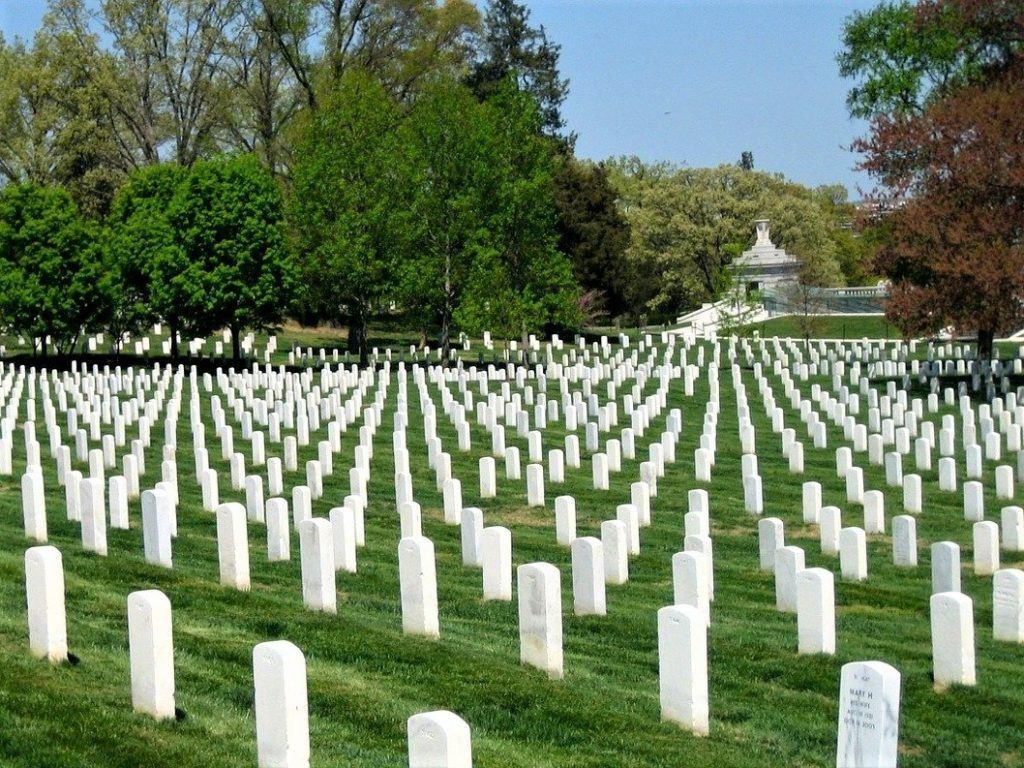Arlington National Cemetery Posted by Gary Locke on May 21, 2020 in Uncategorized
Memorial Day is going to be very different this year. Parades are canceled. Those large community and family cookouts with horseshoe competitions and sack races are not going to happen. Baseball games and soccer matches are forbidden. Even the definition of national sacrifice has been forever altered. But the reason that we set aside the last Monday of May to honor those who gave their lives in service to the country remains the same. And the one place in the U.S. where it all comes together is Arlington National Cemetery in northern Virginia.
Extraordinary Beginnings
The nation’s great cemetery is located on land that once belonged to General Robert E. Lee, the man who led the Army of the Confederate States during the Civil War. Lee’s wife was the daughter of George Washington’s stepson, who built the property which sits across the Potomac River from Washington, DC. Lee left his farm in Arlington to serve as the Confederate commanding general in 1861 and never returned. It was occupied by the Union Army shortly after his departure. In 1864, the government seized the 200 acres outright to serve as a cemetery for the Civil War casualties. The bodies of unidentified soldiers were buried and sealed in a vault in Lee’s rose garden, thus ensuring that the land would be forever uninhabitable to the Lee family. This would come to be known as the Tomb of the Unknown.
This nearly backfired, however. A U.S. Supreme Court ruling decreed that the property had been seized without due process. Congress quickly appropriated $150,000, a vast fortune in 1883, to pay the Lee family for the land. If this agreement had not been reached, over 1700 graves would have been exhumed.
By 1868, the country was looking for a way to honor the dead on both sides of the Civil War. Congress declared May 30 as Decoration Day, when graves of soldiers who fought in the great conflict would be decorated with flowers and flags. The first celebration of Decoration Day was held at Arlington. Eventually the day would become known in 1929 as Memorial Day, to honor all those who died while serving in the armed forces.
More than a Cemetery
Arlington National Cemetery is more than just the land that once belonged to the Lee family. It now extends to 624 acres, including Memorial Drive, Memorial Bridge, and the Hemicycle, a memorial to all the women who served. The Tomb of the Unknowns is now part of Arlington Memorial Amphitheater, which holds state funerals and various memorial ceremonies. More than 400,000 are interred in the cemetery, with approximately 25 burials each day. Amazingly, it is not the largest national cemetery in the country. That distinction is held by Calverton National Cemetery on Long Island, New York, and encompasses 1045 acres.
The Honored Dead
In spite of the fact that Arlington National Cemetery was founded during the Civil War, it also holds veterans of The US Revolutionary War and the War of 1812, making this the only cemetery holding the victims of every conflict ever fought by Americans.
You will also find three prisoners of war from World War II buried at Arlington, two from Italy and one from Germany. They died in custody and, under the rules of the Geneva Convention, their remains required a proper and dignified burial. Field Marshall Sir John Dill was serving at the British Embassy in Washington, DC during World War II when he died, making him the first non-American to be buried at Arlington. Other notable burials are Presidents Taft and Kennedy, along with Kennedy’s brothers Robert, who served as US Attorney General and as a senator, and Edward, a long-term senator from Massachusetts. President Kennedy’s grave is marked by an eternal flame. His widow Jacqueline, and two of their children are buried nearby.
I first visited Arlington a few days after the burial of Joe Louis, the longest-serving World Heavyweight Boxing Champ and one of the legends of African American history. He lost his first bout against Max Schmeling, a German-born favorite of the Nazis in 1936. When they met for a rematch in 1938, the Nazi party issued statements that a black man could not defeat Schmeling and that Schmeling’s prize money would be used to build tanks in Germany. Louis knocked Schmeling down three times before the German could land three blows. On the third knockdown, the fight was over.
I mention this because, on the day that I visited, Louis’ gravestone was not yet in place. Although he had been buried with full military honors, his place among the thousands of white markers was identified with just a small card above his grave which read, “Sargent Joseph Louis, World Champion.” It remains one of the most humbling experiences of my life.

Build vocabulary, practice pronunciation, and more with Transparent Language Online. Available anytime, anywhere, on any device.




